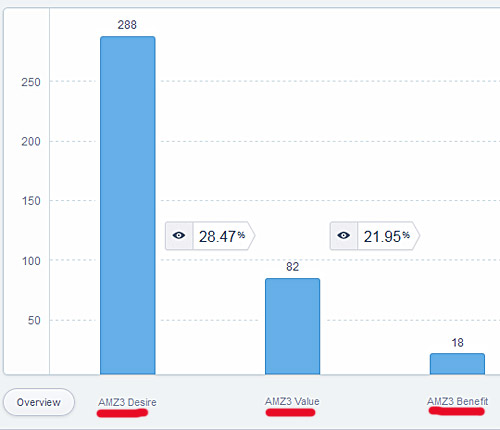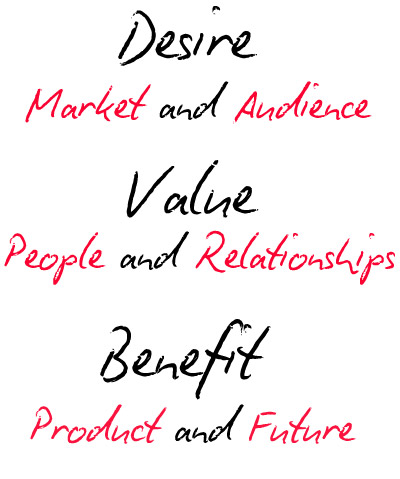Understanding Your Trade

E
very single sale today will come down to just 3 things.
Wanna take a guess? :)
Desire: The demand
Value: The trade
Benefit: The outcome
Online, offline, on Mars. Doesn't matter.
Get one (or two) of these wrong and no sale. Nada.
Desire + Value - Benefit = No Sale
Desire + Benefit - Value = No Sale
Value + Benefit - Desire = No Sale
BUT...
Desire + Value + Benefit = Sale
AND...
Massive Desire + Massive Value + Massive Benefit = Massive Sales
Now, you might be wondering why I chose these three words. After all, aren't there already words like "traffic", "leads", "conversions", "margins", "profit", etc.?
Yes, there are.
But they're terrible words to label human behavior.
Because "traffic" isn't a human trait. Neither is "leads". Nor "profit".
And that's the problem. Over time, the most important element of any trade, people, get lost in the labels.
We all understand these three words. We use these words (or synonyms) in everyday speech between ourselves.
"I don't really want to buy a new van this year. (Desire)
"I wanted that F150, but it was too expensive. (Value)
"I bought that used Jeep, and it has been great. (Benefit)
The other reason for using these terms is that it releases psychological inertia.
Psychological what?...
Think of it this way. When you come to me and say, "I can't make any money online. Help." I could say, "What does your traffic look like?" And you'd probably tell me about some campaign, tool, program, software, etc.
But now imagine if I said, "Who wants what you've got?"
Do you see the difference?
Notice how that question immediately makes you think about PEOPLE instead of systems, software, PPC campaigns, affiliate marketing, etc.? You've now focused your problem solving skills on the important part.
You respond with, "Well, every hunter I know would love to have this widget. It's the best hunting widget in the world. It does 65 critical things..."
Now, imagine if I said, "Well how well is your salesletter converting?"
You'd respond with a bunch of numbers and % and tell me about heatmaps and CTR% and cart rate abandonment.
But imagine how different you would respond if I asked,
"Do they believe it's valuable?" By the way, whether or not you believe your product is valuable matters little in a trade. What the other person believes about the value matters. Your job is to clearly communicate the real value to increase their perceived value.
Notice how that question immediately makes you think about PEOPLE instead of conversion rates, numbers, and heatmaps?
Finally, if I ask you, "What's your profit margin?" or "What's your refund rate?", you'd respond with numbers and charts and excel calculations or analytics dashboard numbers.
But, what happens when I ask, "What benefit are they getting from their purchase?" and "What benefit are you getting from the trade?"
You guessed it.
You immediately start thinking about PEOPLE again.
And that's the real power of the D-V-B framework.
If you ever get "lost", I want you to come back to this framework, and you'll immediately know how to get back home.
It was and still is about PEOPLE.
"Why do you keep saying the word "trade"?
Glad you asked. :)
I personally think the word "trade" does the best job of bringing out the idea of "two" transactions. We use words like "tradeoff" and "bad trade" all the time. I think in some ways, an actual trade between two individuals does the best job of revealing the actual psychology of the sale.
In other words, "why we buy, what we buy, when we buy it".

Tom: I'll give you a duck and some lead for that tractor.
Bill: You know that tractor is worth more than your duck.
Tom: But with the lead, you can go hunting this weekend.
Bill: You're right. I don't need that broken tractor anyway. And Betty is fixing fish tonight. I hate fish. Ok, you got a deal.
See how that works.
That's how a real trade works. It's between two people. Likes. Dislikes. Reasons. Back-and-forth.
Now, you want to know a secret?
That's really how EVERY sale works.
That's what gets lost in labels like "traffic" and "leads" and "conversion rate".
It's Tom and Brenda and Bill and Jenny.
They have desires.
They think about value.
They dream about the benefit.
What are they looking for? What do they need? What are they willing to trade with? What do they hope happens?
In fact, I believe this so much, I setup Mixpanel to track this on a daily basis. It's the first stat I look at every day. And it immediately tells me what I need to work on.

Desire low? Where are these people located? How I can I get their attention? How can I keep their attention?
Value low? What do these people believe about the product? What do they like? What don't like? What are they giving up? What are they getting? What have I said? What have I forgotten to say? How can I demonstrate more value to them?
Benefit low? How are they using it? Will they be willing to pay more for additional value? How has it changed them? How has it changed us?
See how incredibly powerful that is?
Now, I'll let you in on another secret.
Inside D-V-B, there are just two primary key factors.
I'm about to give you both the Golden egg and the Goose.
